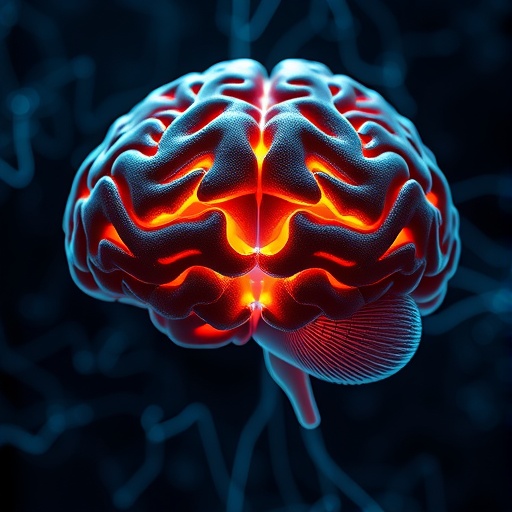In recent groundbreaking research, scientists have delved into the sex-dependent effects of chemogenetic modifications in the nucleus accumbens, a critical brain area associated with reward processing. The study conducted by Chan, Driscoll, and Usmani uncovers the nuanced roles that sex plays in the brain’s response to ethanol reward, particularly focusing on the contrasting effects witnessed when using chemogenetic excitation and inhibition techniques. This research opens new avenues for understanding addiction mechanisms, especially regarding alcohol consumption and gender differences.
The nucleus accumbens is well-known as a central player in the brain’s reward circuitry. It functions as a hub that integrates signals from various neurotransmitter systems, primarily dopamine, that modulate the sensation of reward and pleasure. This latest study builds on existing neurobiological frameworks by specifically addressing how chemogenetic manipulations—tools that allow for the control of neuronal activity in living organisms—can differentially influence reward responses in male and female mice. By dissecting these mechanisms, researchers aim to shed light on the fundamental biological differences underlying addiction behavior between sexes.
At the heart of this research lies the chemogenetic technique, which employs engineered receptors that can be activated or inhibited by an otherwise inert ligand. This selective manipulation facilitates a more precise understanding of the roles of specific neuronal circuits. In this study, the authors employed chemogenetic excitation in male mice and chemogenetic inhibition in female mice, creating a focused experimental approach that highlights sex-based differences in reward processing. The use of these cutting-edge methodologies underscores the advancement in neuroscience that allows for a deeper exploration of complex behaviors like addiction.
Female and male mice displayed distinct behavioral responses to ethanol reward when subjected to these chemogenetic alterations within the nucleus accumbens. While excitation in male mice heightened their ethanol reward responses, inhibition in female mice resulted in decreased reward behavior. These findings not only support the hypothesis that males and females process reward differently but also suggest potential underlying neurobiological mechanisms that may contribute to the higher incidence of alcohol use disorders in men compared to women. Such disparities emphasize the importance of considering sex as a biological variable in addiction research.
The implications of this research extend beyond the laboratory and into public health considerations. Understanding the sex-specific mechanisms responsible for addiction could lead to tailored therapeutic interventions for alcohol use disorders. For instance, targeted therapies that consider hormonal differences, genetic predispositions, and neuronal circuitry variations may enhance treatment efficacy for both sexes. The study emphasizes that one-size-fits-all approaches may not suffice in effectively addressing substance abuse.
Moreover, the work of Chan and colleagues aligns with a growing body of literature advocating for more nuanced approaches to addiction treatment. By identifying the mechanisms that underlie reward sensitivity in male and female populations, clinicians could leverage this information to develop more effective personalized medicine strategies. These findings also raise further questions about the role of societal influences, environmental factors, and genetic predispositions that may interact with biological mechanisms to influence addiction behaviors.
The results of this study also prompt a re-evaluation of existing experimental models used to study addiction. Traditional models often generalize findings across sexes, but the evidence presented by Chan et al. demonstrates significant differences in how male and female subjects respond to similar stimuli. This realization calls for an evolution in research practices, encouraging scientists to not only include both sexes in their studies but to also analyze data through the lens of sex differences, paving the way for discoveries that may have been overlooked.
In addition to the valuable insights regarding alcohol reward mechanisms, the research offers broader implications for understanding other addictive behaviors and substances. As the science of addiction continues to evolve, recognizing the role of gender in reward processing may lead to new strategies for addressing a host of addictive disorders—from opioid dependence to gambling addiction. The interdisciplinary nature of addiction research means that these findings could resonate across fields, influencing psychology, sociology, and neuroscience.
In conclusion, Chan, Driscoll, and Usmani’s research illustrates the power of modern neuroscience techniques in unraveling the complexities of addiction. By focusing on sex-based differences in chemogenetic interventions within the nucleus accumbens, the study shines a light on how male and female brains uniquely process rewards. These insights not only advance our understanding of alcoholic reward systems but also underscore the critical need for personalized approaches in addiction treatment that consider sex as a vital factor.
As further research builds on these findings, it is expected that scientists will uncover even more intricate details about how brain chemistry interacts with behavior in males and females. The continuing exploration of these fundamental questions in neuroscience holds great promise for informing both clinical practice and public health strategies in the realm of addiction treatment and prevention.
Ultimately, this research sets a benchmark for future studies that aim to explore the intersection of neuroscience and behavior through the lens of sex differences. The dynamic nature of brain function in relation to substance use disorders is an area ripe for investigation, and insights gained from such research could play a key role in shaping the future of addiction science and intervention.
Subject of Research: Chemogenetic excitation and inhibition in nucleus accumbens and their effects on ethanol reward in male and female mice.
Article Title: Nucleus accumbens core chemogenetic excitation in male mice and chemogenetic inhibition in female mice reduced ethanol reward.
Article References:
Chan, A.E., Driscoll, G.S., Usmani, Z. et al. Nucleus accumbens core chemogenetic excitation in male mice and chemogenetic inhibition in female mice reduced ethanol reward.
Biol Sex Differ 16, 66 (2025). https://doi.org/10.1186/s13293-025-00745-0
Image Credits: AI Generated
DOI:
Keywords: Chemogenetics, Nucleus Accumbens, Ethanol Reward, Sex Differences, Addiction, Alcohol Use Disorders.




